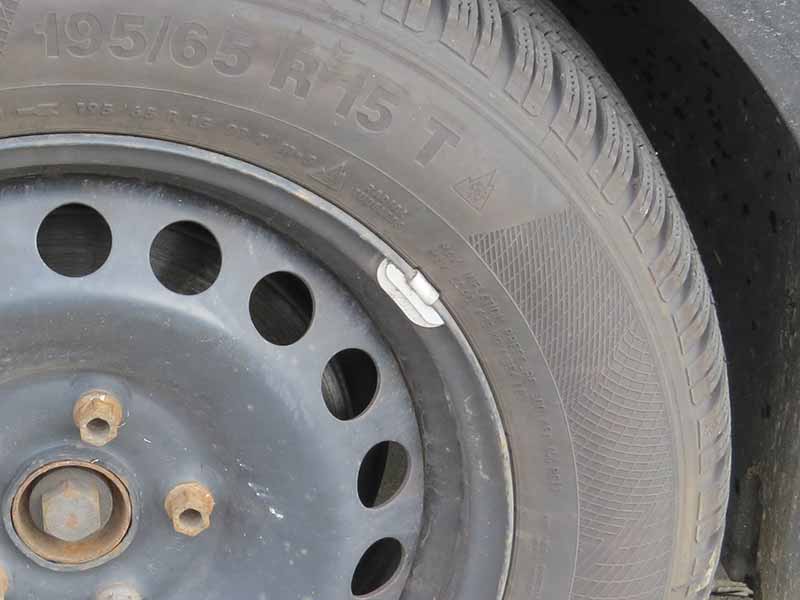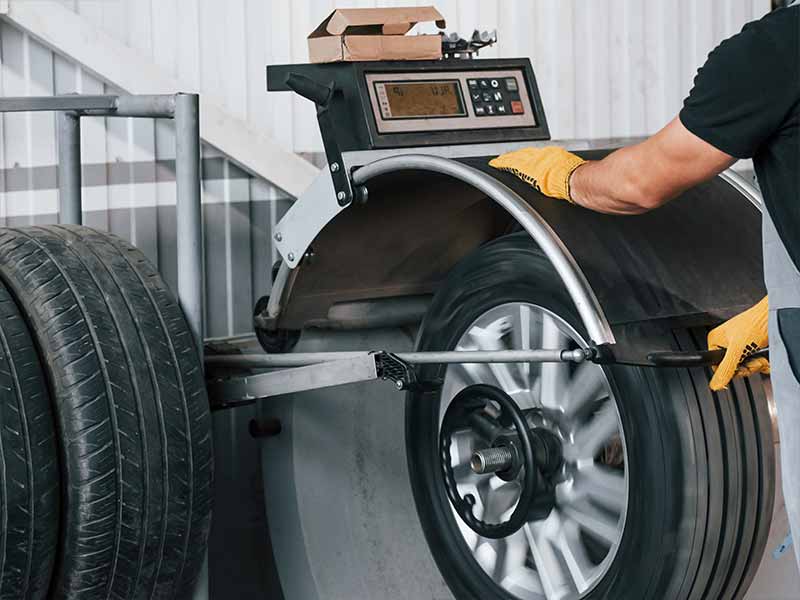Have you noticed your steering wheel vibrating as you drive, or maybe your car doesn’t seem to handle as smoothly as it used to, or you have uneven tread wear? If you’re experiencing these issues, unbalanced tires might be the culprit, and resolving this problem is essential for a safer and more comfortable ride.
How To Fix Unbalanced Tires
To fix unbalanced tires, you can either balance them yourself using a tire balancing machine and wheel weights or seek professional help from a tire shop.
Accurate tire balancing will involve identifying areas of imbalance, applying wheel weights to correct them, and confirming the balance with a re-test.
In this article, we’ll delve into understanding what causes unbalanced tires, how to recognize the symptoms, and both DIY and professional solutions to fix them. You’ll learn about different types of tire balancing techniques and when it’s advisable to seek expert assistance.
Let’s take a closer look.

Understanding Unbalanced Tires
Understanding the root causes of unbalanced tires can save you both time and money in the long run. Here are the common factors that lead to tire imbalance:
- Natural Tire Wear: As you drive, your tires wear down. Sometimes, this wear isn’t even across the tire, leading to imbalance.
- Wheel-Tire Assembly Errors: When a tire and wheel are first put together, if they aren’t perfectly aligned or the wheel weight isn’t evenly distributed, the tire can become unbalanced.
- External Factors: Hitting potholes, speed bumps, or even curbs can throw your tires out of balance.
It’s worth noting that tire manufacturers aim to produce perfectly balanced tires, but real-world driving conditions often make that difficult to maintain.
Common Symptoms of Unbalanced Tires
If you’re driving and something feels off, you might be dealing with unbalanced tires. It’s important to recognize these signs early to prevent further issues.
Steering Wheel Vibration
- One of the most common signs is a vibrating steering wheel, especially at certain speeds.
- This usually indicates that one of the front tires is out of balance.
Uneven Tread Wear
- If you notice that your tires are wearing out unevenly, this is often a sign of unbalanced tires.
- For example, you might notice more wear on one side of the tire than the other.
Unbalanced Tire Wobble
- At high speeds, you may experience a wobbling sensation.
- This is more common in the rear wheels and can be quite dangerous if not addressed promptly.
Identifying the Problem Tire
To pinpoint which tire is causing the issue, here are some tips:
- Front vs. Rear: If you feel the vibration more in the steering wheel, it’s likely a front tire. If you feel it in the seat or floor, it’s probably one of the rear tires.
- Visual Inspection: Sometimes, you can see visible signs of wear or damage that indicate which tire is unbalanced.
- Professional Diagnosis: When in doubt, take your vehicle to a tire shop where experts can perform precise tests to identify the unbalanced tire(s).
Types of Tire Imbalance
Understanding the types of imbalance can help you better diagnose and fix the problem.
Static Imbalance
- This is the simplest form of imbalance and means there is an uneven distribution of weight in the tire that can usually be fixed by adding wheel weights.
Dynamic Imbalance
- This form is a bit more complicated. Dynamic imbalance occurs when there’s an uneven weight distribution that changes as the tire rotates.
- This usually requires a tire balancer for a more comprehensive fix.

The Importance of Tire Balance
Before diving into the specifics, it’s crucial to understand why tire balancing is essential. Properly balanced tires provide a smooth ride and reduce wear and tear on your vehicle’s suspension system. It’s not just about comfort; it’s also about long-term vehicle health.
Static vs Dynamic Balancing
Understanding the two main types of tire balancing can help you make an informed decision on what your vehicle needs.
Static Balancing
- What it is: Static balancing involves making sure the tire’s weight is evenly distributed when it is stationary.
- How it’s done: Wheel weights are usually added to the lighter side of the tire to balance it out.
- Indications: If your tire is statically imbalanced, you might experience a up-and-down bouncing motion when you drive.
Dynamic Balancing
- What it is: Dynamic balancing is about ensuring that a tire is balanced throughout its rotation.
- How it’s done: A tire balancer rotates the tire to identify imbalance across multiple points. Wheel weights are then added where needed.
- Indications: Dynamic imbalance often shows up as a side-to-side wobble or a vibrating steering wheel.
High-Speed vs Road Force Balancing
After covering static and dynamic balancing, it’s good to know about specialized balancing methods tailored for different needs.
High-Speed Balancing
- What it is: This is the standard method used in most tire shops. It’s ideal for everyday driving conditions.
- How it’s done: The tire is spun at high speeds on a tire balancer to identify imbalances.
- When to Use: High-speed balancing is generally sufficient for most passenger cars and trucks used for daily driving.
Road Force Balancing
- What it is: This is a more advanced form of balancing that also considers the tire’s stiffness and how it interacts with the road.
- How it’s done: Specialized equipment applies pressure to simulate road conditions while the tire spins.
- When to Use: This method is often recommended for high-performance or luxury vehicles where a more precise balance is desired.
Wheel Weights and Their Role
A central element in tire balancing is the use of wheel weights.
- Types of Weights: There are different types of wheel weights, such as clip-on and adhesive weights. Each has its own set of pros and cons.
- Placement: Wheel weights are placed on the inner or outer surface of the wheel. The type and placement are often determined by the type of imbalance your tire has.
- Material: Wheel weights can be made from various materials like lead, zinc, or composite materials. The choice often depends on local regulations and the specific needs of the vehicle.

Inexpensive Tire Bubble Balancer
How To Balance Tires Yourself
Before you get started on balancing your own tires, it’s essential to be well-prepared. You’ll need some specific tools and a good understanding of the basics of how tires work.
Equipment You’ll Need
- Tire Balancer: A must-have for this task; it helps identify where the tire is out of balance.
- Wheel Weights: These are used to balance out the areas of the tire that are lighter.
- Wrench: To remove and tighten lug nuts.
- Jack and Jack Stands: To lift the vehicle and safely secure it while you work on the wheels.
Step-by-Step Overview to Balancing Your Own Tires at Home
If you’ve decided to balance your tires at home, the following steps can guide you through the process.
Step 1: Safety First
- Lift the Vehicle: Use a jack to lift the car off the ground and secure it with jack stands.
- Remove the Wheel: Use a wrench to loosen the lug nuts and remove the wheel from the car.
Step 2: Mount the Wheel on the Balancer
- Prepare the Balancer: Ensure the tire balancer is in good working condition.
- Mount the Tire: Carefully mount the wheel tire assembly onto the machine.
Step 3: Identify Imbalances
- Run the Machine: Start the tire balancing machine. It will spin the tire and identify areas where the wheel is out of balance.
- Read the Results: The machine will provide readings that show where the tire is heavier or lighter.
Step 4: Apply Wheel Weights
- Locate the Spot: Identify the area where the wheel weight needs to be placed.
- Attach the Weight: Firmly attach the appropriate wheel weight at the designated spot.
Step 5: Recheck Balance
- Run the Machine Again: Spin the tire once more on the machine to ensure it’s now balanced.
- Make Adjustments: If further imbalances are detected, repeat the process of adding or adjusting wheel weights.
When To Seek Professional Help
Even though balancing your tires at home can save you money, there are times when it’s best to seek professional help.
- Complex Issues: Problems related to rear wheels or dynamic imbalances may require a more advanced tire balancing machine.
- Limited Experience: If you’re not confident in your skills, it’s better to take your vehicle to a professional tire shop.
When to Rely on Trained Tire Technicians
DIY tire balancing is a skill that can save you money and provide a sense of accomplishment. However, there are times when you should consider seeking professional assistance. Understanding your own limitations is key to ensuring your vehicle’s safety and performance.
Why Go To a Professional?
- Expertise: Professionals in a tire shop have the expertise and the right equipment to accurately diagnose and correct more complex imbalances.
- Efficiency: Experts can often complete the job more quickly, saving you time.
- Guarantees: Many tire shops offer warranties or guarantees on their work, providing you peace of mind.
Common Scenarios for Professional Help
There are several situations where it may be more advisable to seek professional help:
Rear Wheels
- Complex Balancing: Rear wheels often require a different balancing technique that may be too complex for the average DIYer.
- Special Equipment: Some advanced types of rear wheel imbalances might require special equipment only available at a tire shop.
Dynamic Imbalance
- Advanced Machinery: Dynamic imbalance usually requires a tire balancing machine that can perform both static and dynamic balancing, something not every DIYer has access to.
Road Force Balancing
- Specialized Needs: If your vehicle is high-performance or a luxury model, road force balancing might be necessary. This is rarely a job that can be performed at home.
How to Choose a Reliable Tire Shop
If you decide that professional help is the best route, it’s crucial to choose a reliable tire shop. Here are some tips:
- Read Reviews: Online reviews can give you a good sense of the shop’s reputation.
- Ask for Recommendations: Friends or family members can often provide insights into a shop’s reliability and quality of work.
- Check Certifications: Reputable shops often have certifications from tire manufacturers or automotive organizations.
- Visit the Shop: Sometimes a quick visit can help you assess the shop’s professionalism and the equipment they use.
Resources
Below are some links you may find helpful when learning about tires
- How do I know if my tires need to be balanced? – Les Schwab
- Everything you need to know about tire balancing – Firestone
Final Thoughts
Whether you opt for the DIY approach or decide to consult professionals, it’s essential to recognize the signs of tire imbalance like a shaking steering wheel or uneven tire wear.
Good luck and happy motoring.






